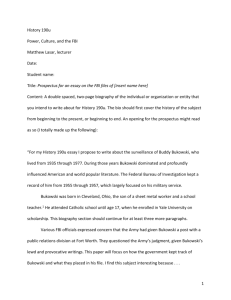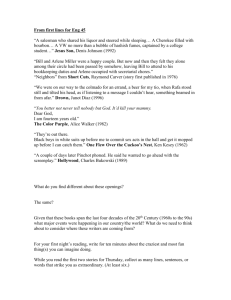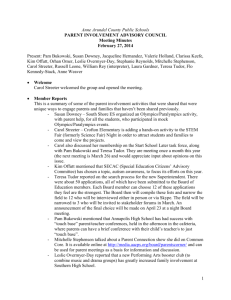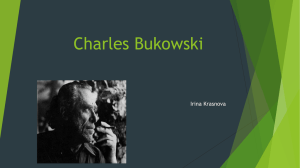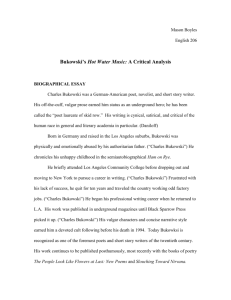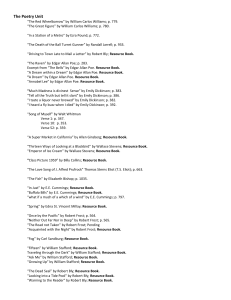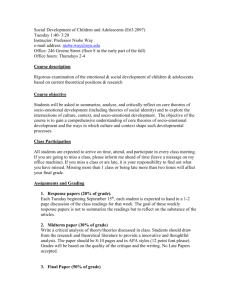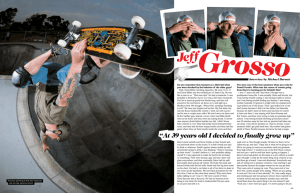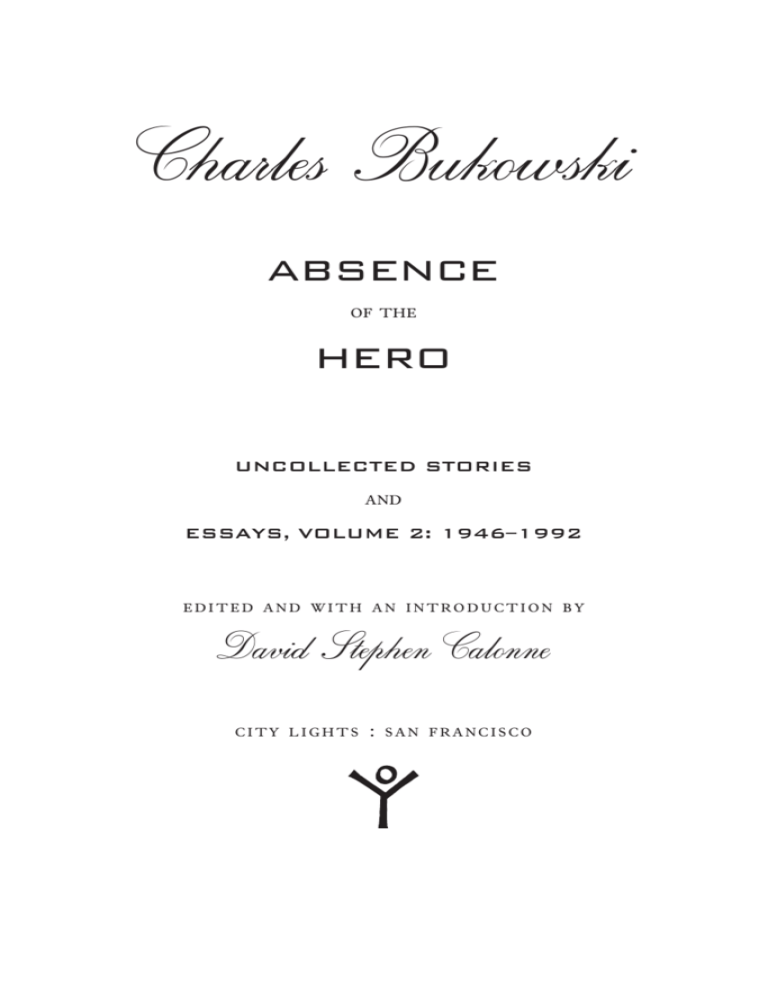
Charles Bukowski
absence
OF THE
hero
UNCOLLECTED STORIES
AND
ESSAYS, VOLUME 2: 1946–1992
E D I TED AND WITH AN INTRODUCTION BY
David Stephen Calonne
CITY LIGHTS : SAN FRANCISCO
Copyright © 2010 by The Estate of Charles Bukowski
Introduction copyright © 2010 by David Stephen Calonne
All rights reserved
Cover design: Jeff Mellin www.bigblueox.net
Library of Congress Cataloging-in-Publication Data
Bukowski, Charles.
Absence of the hero : uncollected stories and essays, volume 2: 1946–1992 /
by Charles Bukowski ; edited, with an introduction, by David Stephen Calonne.
p. cm.
Includes bibliographical references.
ISBN 978-0-87286-531-0
I. Calonne, David Stephen, 1953— II. Title.
PS355⒉U4A6 2010
811'.54—dc22
2009049106
Visit our website: www.citylights.com
City Lights Books are published
at the City Lights Bookstore
261 Columbus Avenue
San Francisco, CA 94133
CONTENTS
ACKNOWLEDGMENTS
[IX]
INTRODUCTION
[XI]
the reason behind reason
[1]
Love, Love, Love
[5]
cacoethes scribendi
[8]
the rapist’s story
[13]
80 airplanes don’t put you in the clear
[25]
manifesto
[32]
peace, baby, is hard sell
[34]
examining my peers
[39]
if i could only be asleep
[42]
the old pro
[44]
review of ginsberg/zukofsky
[49]
bukowski on bukowski
[56]
notes of a dirty old man
[59]
the absence of the hero
[64]
christ with barbecue sauce
[68]
ah, liberation, liberty, lilies on the moon!
[75]
the cat in the closet
[78]
notes of a dirty old man
[87]
sound and passion
[92]
i just write poetry so i can go to bed
with girls
[99]
the house of horrors
[112]
untitled essay on d. a. levy
[115]
henry miller lives in pacific palisades and I live
on skid row, still writing about sex
[117]
a foreword to these poems
[126]
the outsider
[129]
vern’s wife
[140]
notes of a dirty old man
[144]
notes of a dirty old man
[149]
he beats his women
[154]
notes of a dirty old man
[157]
notes of a dirty old man
[162]
notes of a dirty old man: “notes of a dirty old
driver of a light blue 1967 volkswagen trv 491”
[166]
the big dope reading
[171]
east hollywood: the new paris
[188]
the gambler
[211]
the ladies man of east hollywood
[221]
the bully
[245]
the invader
[255]
playing and being the poet
[271]
SOURCES
[274]
INTRODUCTION
Charles Bukowski composed a sequence of six stories between
1944 and 1948, including “Aftermath of a Lengthy Rejection Slip”
(1944) in Story, “20 Tanks from Kasseldown” (1946) in Portfolio III,
and the quartet appearing in Matrix: “The Reason Behind Reason” (1946), “Love, Love, Love” (1946–47), “Cacoethes Scribendi”
(1947), and “Hard Without Music” (1948).1 “The Reason Behind
Reason”—although decorated with Bukowski’s first published drawing, depicting a baseball player comically reaching out to catch a fly
ball—is pervaded by an eerie sense of disquiet. The main character
Chelaski is puzzled, enigmatic, muted, withdrawn; he sees no reason
to perform his appointed role in the game because, like the game
of life, it is an absurd one. Bukowski pays close attention to the
oddly-observed disconnected small detail and demonstrates his early
mastery of fictional craft: “fire on things sticking in mouths” of the
spectators; “the thick veins in the red neck” of Jamison; a rhythmical, lyrical flash of erotic mystery from the girl in the grandstand
with “a green skirt, and a pleat in a green skirt, shadow-like, and
leaping.”
Like Roquentin in Jean-Paul Sartre’s La Nausée (1938), who experiences the world as “out there” and is made ill by the chestnut
tree’s horrible quiddity, so too Chelaski feels “different,” adrift in
an indifferent universe where “things don’t set right” and “even the
sun looked a little sick, the green of the fences too green, the sky
much too high” and a weird recurring bird “skipped through the
air, up and down, somewhere, very fast.” The title “The Reason
Behind Reason” suggests an inscrutable riddle occluded behind the
reasons we invent to interpret our experience. Whatever meanings
there might be are so unreasonable that they are best passed over
in silence. It is the individual, questioning poet who is lost, while
xi
the crowd “all hung together in a strange understanding.” This is
the solitary mystical zone where nothing and nobody connect; we
should remember that one of Bukowski’s favorite novels was Carson
McCullers’ The Heart is a Lonely Hunter.2
“Cacoethes Scribendi” concerns an editor/writer who seeks an
assistant for his literary magazine. Again the mood is uncanny, with
strange perturbations in the atmosphere, the abstruse word choice
purposely jarring: “suzerain,” “diacritic,” “acephalous,” “zebu,” “argute.” The title is taken from Juvenal’s Satire VII and may be translated as “an incurable endemic writer’s itch,” which precisely describes Bukowski himself since he was a hard-working, ceaselessly
productive writer, constantly submitting poems, stories, and essays
to virtually every literary magazine in the United States (and several
in Europe).3 Indeed, contrary to the myth fostered by the author
himself, he did not fall silent after 1948, the period of his infamous
“ten-year drunk” when he claimed to have written nothing. In fact,
he submitted poems to Poetry (Chicago) between 1953 and 1956 and
published the poems “The Look” in Matrix in 1951, “Lay Over” in
Naked Ear in 1956, “These Things” and “You Smoke a Cigarette”
in Quixote 1956, “Poem for Personnel Managers” and “As the Sparrow” in Quixote 1957, and “Mine” in Wallace Berman’s Semina 2
in 195⒎4
“80 Airplanes Don’t Put You in the Clear” (1957) is noteworthy
as the first work in which the narrator is named “Hank,” while
in “Love, Love, Love” the main character is “Chuck” and in “The
Reason Behind Reason” he is “Chelaski.” Bukowski would finally
settle on Henry (“Hank”) Chinaski (derived from his given name
Henry Charles Bukowski, Jr.) as his literary alter ego. This story
marks a return to the more whimsical tone of “Aftermath” and the
tale is built around D.H. Lawrence’s biography: his failed attempt
to found the colony of Rananim with his friends, his wife Frieda von
Richthofen, and her kinship with “The Red Baron,” Manfred von
xii / introduction
Richthofen. The allusion to the Red Baron returns us to Bukowski’s
literary beginnings; one of the first stories he invented as a child
concerned the German World War I fighter pilot.5 Richard Aldington, Homer, Shakespeare, Twain, Stevenson, Huxley, Confucius,
and Beethoven are all invoked during a night of playful drinking and
womanizing. Wein, Weib, und Gesang—wine, women, and song, or
alcohol, sex, and poetry/music—would become Bukowski’s obsessive thematic holy trinity; if one exists in his narratives, the other
two will surely be present.
Bukowski’s transgressive sexual writing begins with “The Rapist’s
Story.” Though it was published in Harlequin in 1957, Bukowski
had actually submitted it to Story in 1952, thus predating Vladimir
Nabokov’s Lolita (1955) by three years.6 It is clear from a psychoanalytic perspective that the cycle of stories about violation (“The
Fiend” from 1970 is a later example) are replayings of Bukowski’s
own terrorized childhood at the hands of his violent father. His
unpublished essay “Ah, Liberation, Liberty, Lilies on the Moon!”
illustrates his compassion for the victims of child abuse as well as
his sensitivity to animal cruelty. Later, in his “Notes of a Dirty Old
Man” columns, he would continue to experiment with explicit erotic
themes, and when he quit his position in the Los Angeles Post Office in 1970 to begin his career as professional writer, he began to
consciously create increasingly sexual and violent narratives in order
to successfully market his work to adult magazines.
Bukowski alternated between composing fiction and poetry, but
when he wrote essays, they were most frequently devoted to literary polemics. He often seemed particularly concerned to distinguish
himself as a solitary creator separate from the various “schools” of
American poetry: Imagist, Confessional, Objectivist, Black Mountain, Deep Image, New York, Beat. In “Manifesto,” he takes aim
at the “university poets,” a familiar target throughout his career.
The essay is perhaps a parody (the vocabulary—“nosography,”
introduction / xiii
“censorious dictum,” “heuristic,” “steatopygous,” “hierophants”—is
obviously outrageous) of the genteel literary criticism of his day,
which he enjoyed reading in the Kenyon Review or the Sewanee Review. In opposition to the pampered ivory tower boys, Bukowski is
at pains to remind us that he lived by the Aeschylean dictum pathei
mathos: through suffering comes wisdom, inspiration, creativity. In
“He Beats His Women,” he asserted: “The gods were good to me.
They kept me under. They made me live the life. It was very difficult for me to walk out of a slaughterhouse or a factory and come
home and write a poem I didn’t quite mean. And many people write
poems they don’t quite mean. I do too, sometimes. The hard life
created the hard line and by the hard line I mean the true line devoid of ornament.” A more concise statement of Bukowski’s poetics
would be difficult to find.
In another of his essays on the writing life, “The House of Horrors,” he makes sarcastic observations about poets who “are quite
comfortable with TV sets, air coolers, loaded refrigerators, and apartments and houses by the sea—mostly at Venice and Santa Monica,
and they sun themselves in the day, feeling and looking tragic, these
male friends (?) of mine and then at night, lo, perhaps they have
a bottle of wine and a watercress sandwich, followed by a wailing
letter of their penury and greatness to somebody somewhere.” It is
a Romantic conceit, but for Bukowski many poets were mild-mannered reporters who did not honor Nietzsche’s mighty apothegm
in Also Sprach Zarathustra: “Of all that is written I love only what a
man has written with his blood.”7 And he would agree with Charles
Péguy, who remarked: “Un mot n’est pas le même dans un écrivain
et dans un autre. L’un se l’arrache du ventre. L’autre le tire de la
poche de son pardesssus.” “A word is not the same with one writer
as with another. One tears it from his guts. The other pulls it out
of his overcoat pocket.”
The subject matter of Bukowski’s writing is very frequently
xiv / introduction
writing itself: his constant effort to define the act of composing in
relationship to an authentically lived life, his theories of creativity
and poetics, his admiration for other writers, as well as his connections to editors. His essay “The Outsider,” which appeared in
1972 in The Wormwood Review, is his tribute to Jon Edgar and
Gypsy Lou Webb. Marvin Malone’s Wormwood Review, Douglas
Blazek’s Ole, and in Germany Carl Weissner’s Klactovedsedsteen—all
were central in slowly establishing the readership that would launch
Bukowski to world fame.8 Yet most important of all would be John
Martin’s Black Sparrow Press; one of Bukowski’s several portraits of
Martin appears in his 1981 story “East Hollywood: The New Paris.”
And Bukowski himself edited two little magazines: Harlequin, with
his first wife Barbara Frye and later, briefly, Laugh Literary and Man
the Humping Guns, with Neeli Cherkovski.
Indeed, Bukowski’s involvement with the underground press
both as contributor and editor put him in the direct line of combat
during the contentious struggle for free speech during the ’50s, ’60s,
and ’70s. As early as 1957, Wallace Berman was raided by the Los
Angeles vice squad.9 In 1966, Steve Richmond, who had published
Bukowski in his magazines Earth and Earth Rose, had writings from
his bookshop in Santa Monica confiscated.10 d.a. levy, the dynamo
of the “mimeo revolution,” published Bukowski’s poem The Genius
of the Crowd, which was seized by the police: “levy was arrested
and jailed along with Jim Lowell (proprietor of the great Asphodel Bookshop, a welcoming home for new poetry for over thirty
years) on charges of distributing obscene material in Cleveland.”11
When John Bryan asked Bukowski to edit Renaissance 2 in September 1968, he solicited a story by Jack Micheline titled “Skinny
Dynamite,” about “a red-haired New York girl who liked to fuck,”
which resulted in Bryan’s arrest.12
Thus as a creature of the underground and as an advocate of
freedom of speech, Bukowski had always been in sympathy with
introduction / xv
the ideals of the counterculture. And as we see from his anti-war
essay, “Peace, Baby, Is Hard Sell” (1962), at the beginning of the
Sixties Bukowski was in accord with pacifism and love, although
he put on the outer mask of the tough guy misanthrope to hide
his essential tenderness. It should come as no surprise, then, that
Bukowski would have deep links with the Beat writers. Although
the nature of his connection to the Beats has been a matter of some
controversy among literary historians, he read their work closely
and appeared with them in many of the same publications, such
as The Outsider, Evergreen Review, Beatitude, Transatlantic Review,
City Lights Anthology, Klactovedsedsteen, Acid: Neue Amerikanische
Szene, Unmuzzled Ox, El Corno Emplumado, Semina, Hearse, Wild
Dog, Naked Ear, and Bastard Angel. And as the Sixties progressed,
an increasing number of significant writers in Beat circles came
to appreciate his work; Kenneth Rexroth would positively review
Bukowski’s It Catches My Heart in Its Hands in the New York
Times on July 5, 196⒋13
Bukowski had corresponded with Harold Norse and his tribute to
him,“The Old Pro,” appeared in 1966 in Ole, an important “mimeo
revolution” publication edited by Douglas Blazek. The two poets
met when Norse moved to Venice, California in January 196⒐14
Bukowski reviewed Allen Ginsberg’s Empty Mirror in Ole in 1967
and at the beginning of 1968 encountered Neal Cassady (“Dean
Moriarty” in Jack Kerouac’s On the Road), who became the subject of one of his “Notes of a Dirty Old Man” columns.15 In 1969,
Bukowski would appear with Norse and Philip Lamantia in Penguin
Poets 13. City Lights published Erections, Ejaculations and Other
Tales of Ordinary Madness in 1972 and Lawrence Ferlinghetti sponsored Bukowski’s first reading in San Francisco at the City Lights
Poets’ Theater in September 1972 and also reprinted Notes of a
Dirty Old Man in 1973 following its initial appearance in 1969 under the Essex House imprint.16 And in November 1974, Bukowski
xvi / introduction
read with Ferlinghetti, Snyder, and Ginsberg at the Santa Cruz
Poetry Festival.17
Thus Bukowski’s writings derive their power not only from his
boisterous, energetic, autobiographical voice, but from the fact that
they are vivid chronicles of the Sixties counterculture. For example,
Gregory Corso is affectionately portrayed in “I Just Write Poetry
So I Can Go to Bed with Girls.” Jack Micheline becomes a lively
“Duke” in a “Notes of a Dirty Old Man” column from 1973, while
d.a. levy, who committed suicide in 1967, was the subject of two
essays: “The Deliberate Mashing of the Sun” and an article in The
Serif, the literary magazine of Kent State University. Leroi Jones
(Amiri Baraka) is the subject of one of his “Notes of a Dirty Old
Man” columns, while Robert Creeley is pilloried in the Literary
Times essay “Examining My Peers.” It is clear then—his own many
disavowals to the contrary—that Bukowski’s career was in many
ways inextricably bound to the Beats.
One area of common ground with the Beats was Bukowski’s development of his own style of “spontaneous prose composition,” which
sought to depict everything about the human body and imagination normally ignored, shunned, and rejected as “vulgar.” In “The
Absence of the Hero,” Bukowski struggled to record violent, scatological, fascinating, grotesque images as they emerged unbidden in
convulsive patterns from the depths of the unconscious. Here the
words seem to be energetically thrown upon the page randomly but
nevertheless they fall into a vital pattern. He records discrete perceptions, even notating the passage of time—“3:24 A.M.”—in diary-like
fashion as if to catch the very movement of fragmented consciousness through time. The story also illustrates Bukowski’s alternating
use of lines of capital and lowercase letters, the use of jagged line
spacing, lists of capitalized sentences—all as if he is attempting to
paint or draw with words. He experimented frequently in his prose
with punctuation, type size, ellipses, idiosyncratic spellings, and
introduction / xvii
repetitions—some of his narratives were entirely composed in lower
case, thus transporting into prose some of e.e. cummings’ poetic
typographical playfulness.
This emphasis on the appearance of the text—he often illustrated his stories, poems, and letters with cartoons and drawings,
while his early stories were actually combinations of words and illustrations—shows that Bukowski frequently strove to make the text
itself into an image. He was actually ahead of his time, anticipating
the current craze for “graphic fiction” since he obsessively joined text
to image in his hand-printed stories from the mid- to late ’40s.18 As
we see in “East Hollywood: The New Paris,” Bukowski devoted a
serious amount of time to his drawing and painting, and many of the
deluxe editions of his work are accompanied by original art. So too
the text of “The Absence of the Hero” reveals that Bukowski was
a kind of Action Writer: he tried to make words perform, act out
their meaning in a quasi-visual way in the same fashion that Jackson
Pollock performed the spontaneous act of creation by “randomly”
yet accurately flinging paint on canvas.
Bukowski would develop a hard, comic, lyric realism, a toughness, but underneath an abiding sensitivity and a photographic, documentary fidelity to everyday horrors. In his “Notes of a Dirty Old
Man” columns, he records the humdrum facts of city life: drivers in
Los Angeles, a confrontation between Nazis and Marxists, joyous
nighttime sessions with his drunken landlady and landlord. He often writes the prose equivalent of William Carlos Williams’ “This is
just to say,” telling you precisely what is in front him without commentary. He addresses the reader directly, removing any barrier between writer and audience. And he strengthened his vulnerable, hurt
self by muscling it with irony, by a subversive, mocking, irreverent
sharpness of observation. Bukowski’s prose became more accomplished with time and his narratives more skillful: he would begin
in medias res with an outrageous opening scene to hook readers and
xviii / introduction
draw them into the story, as in “The Cat in the Closet.” This story
is also a marvelous example of the ways he casts his alter ego as a
comical, self-deprecating, helpless character lost in a universe where
things just happen.
The unexpected references to Stravinsky, Mahler, Hemingway,
Camus’ The Stranger, Maxwell Bodenheim, and Berlioz against the
backdrop of graphic sexuality and comic drunken self-abasement
are typical examples of a literary device Bukowski frequently employs. These surprising, sudden allusions to cultural figures serve
to “equalize” “highbrow” and “lowbrow” culture to comic effect and
are a kind of “winking” by the narrator to the reader, signaling that
our hapless anti-hero may be a clown, but he is smarter than he
lets on. So too Bukowski seeks to entertain us by playing the fool;
he gives us our existential lesson, but with a knowing smile. His
characters do not grow, achieve epiphanies, or reach enlightenment.
Rather, as the Buddha said in the Diamond Sutra: “I obtained not
the least thing from complete, unexcelled awakening, and it is for
that very reason it is called complete, unexcelled awakening.”
With increasing fame, Bukowski began to give poetry readings
throughout the U.S.: in California (Los Angeles, Santa Cruz, San
Francisco), New Mexico, Washington, Utah, Illinois, New York, and
Wisconsin as well as in Vancouver, Canada, and Hamburg, Germany. He also made a rambunctious appearance on the famous television talk show hosted by Bernard Pivot in Paris, Apostrophes. And as
always, life fed his art as he began to chronicle his life on the road in
his poems, stories, essays, and novels. He became a “literary hustler,”
and he satirizes himself, and depoeticizes and deromanticizes poetry;
he turns the lofty poetry reading into a ritual in honor of the god
Dionysus, complete with rivers of wine and ecstatic maenads.19
The sexual revolution of the Sixties coincided with Bukowski’s
own raw and direct confrontation with his own sexuality. Due
to his acne vulgaris and tortured childhood, Bukowski had never
introduction / xix
experienced a “normal” adolescence and he spent 1970–1977 playing
catch-up for all the delights he had missed as a Southern Californian teenager. In “The Big Dope Reading,” for example, we see
Bukowski at the height of his powers, engaging in multiple levels
of irony and self-parody. The title itself may carry a double entendre: “dope” as in marijuana, but also the Big Dope equals the
Poet as Clown. Bukowski gives his readers a hilarious moment of
deadpan self-parody when Chinaski quotes two of the most famous
Bukowski apothegms—“Genius . . . could mean the ability to say
a profound thing in a simple way” and “Endurance is more important than truth”—which are in-jokes for devoted Bukowskians.
Here too there are complex moments when he is at once parodying erotic writing, himself, and the convolutions of sexual/romantic
“relationships” (he would have been allergic to such a psychobabble
word). Bukowski often plays at the “meaning” of “relationships” in
a teasing, Zen way which recalls Jacques Lacan’s gnomic apothegm:
“There is no sexual relationship.” He stripped himself down to
show his vulnerability, his wounds, trying to recover through love
what was lost in his childhood yet, at the same time, poking fun at
the effort to find salvation through love and sex.20 Yet Bukowski is
also of course really a romantic who could write of falling in love in
his June 24, 1974 “Notes of a Dirty Old Man” column: “I walked
about and it felt as if the sun were inside of me.” And as one of his
favorite poets, e.e. cummings, wrote: “unlove is the heavenless hell
and homeless home . . . lovers alone wear sunlight.”21
Bukowski’s “defense mechanism” to ward off psychic anguish is
of course laughter. Wit, an unerring sense of comic timing, and a
driving inexorable energy power his writings; his beloved Renaissance brothers in manic extravagance were François Rabelais and
Giovanni Boccaccio.22 He could also be sardonic, which was in perfect accord with the Zeitgeist: black humor would mark the counterculture of the ’60s and ’70s. Who’s Afraid of Virginia Woolf (1966),
xx / introduction
One Flew Over the Cuckoo’s Nest (1975), and Eraserhead (1978) were
among his favorite films—humor and madness in close and delicate
counterpoint.23 So too, Bukowski’s writing is poised between despair
and lyricism, moving forward with a vigorous power that virtually
always redeems his writings from nihilism. His admiration for the
genius of Robert Crumb (who illustrated several Bukowski works)
shows that for Bukowski there is a nexus between pain, laughter,
and quasi-German-Expressionist extreme states of emotion.
After he tendered his resignation at the post office at age 50,
Bukowski demonstrated that he could be a practical working writer
and he maximized his productivity by reassembling his plots in differing contexts. He not only recycled favorite narratives in stories
and novels, but he even recast them in both story and poem: “Fooling Marie” exists in both forms. Furthermore, sections from Post
Office, Factotum, and Women all appeared initially in his “Notes of
a Dirty Old Man” column in the LA Free Press as separate stories. Chapter 30 from Women appeared in two installments and in
comparing the story and novel versions, one can see how much he
altered and revised; in this case, many splendid passages were left on
the cutting-room floor as he shaped his prose into novel form. This
method of composition made perfect sense, since Bukowski’s fiction
had always been episodic, constructed out of brief sections strung
together. His novels are in a way a series of connected brief tales,
which enabled him to detach sections for submission to magazines
as separate short stories as he composed them. And there was yet
another mode of literary proliferation: Bukowski’s work was circulated among many underground publications under an agreement
with the United Press Syndicate (UPS) which allowed articles to be
reprinted by all members of the organization.24
As suggested above, perhaps due to both the loosening of censorship restrictions during the ’60s and ’70s as well as his own desire to
explore more fully the darker reaches of his imagination, Bukowski
introduction / xxi
would begin to experiment more dramatically with direct portrayals of violence.25 Films such as The Wild Bunch (1969), Easy Rider
(1969), and A Clockwork Orange (1971) laid the groundwork for a
story such as “Christ with Barbeque Sauce,” in which Bukowski
used an actual newspaper account as the source for his narrative.26
In later stories such as “The Invader” (1986), Bukowski traces the
sudden incursion of terror into the banalities of everyday life: tales
of ordinary madness. This story also recalls his earlier apocalyptic
portrayals of the human inability to fathom primal wildness in stories such as “Animal Crackers in My Soup.”
Bukowski’s late, lovely cycle of poems about his cats reveals them
to be creatures who preserve the style, poise, and lack of pretense
that are so sorely lacking in human beings. And in one of his very
last essays, Bukowski asserts that most people lose their magic at a
very young age. In “Playing and Being the Poet,” he returns to his
musings about the life of the poet: “Poetry comes from where you’ve
lived and from what makes you create it. Most people have already
entered the death process by the age of 5, and with each passing year
there is less of them in the sense of being original beings with a
chance to break through and out and away from the obvious and the
mutilating.” For Bukowski, living life poetically is in fact the only
way to really live.
NOTES
⒈ “Aftermath of a Lengthy Rejection Slip,” “Twenty Tanks from Kasseldown,”
and “Hard Without Music” may be found in Charles Bukowski, Portions from
a Wine-Stained Notebook: Uncollected Stories and Essays, 1944–1990, ed. and
with an introduction by David Stephen Calonne, San Francisco: City Lights,
200⒏ The early stories are remarkable not only for their style and approach,
but also because they encapsulate virtually all of the major themes that would
preoccupy Bukowski throughout his career: his romantic and erotic quest,
sense of alienation, troubled family history, discovery of alcohol, struggles to
be a writer, and love of classical music.
xxii / introduction
⒉ See “Carson McCullers” in The Night Torn Mad With Footsteps, Santa Rosa:
Black Sparrow Press, 2001, p. 3⒌
⒊ Juvenal, Satires VII, ll. 50–52: “Nam si discedas, laqueo tenet ambitiosi/consuetudo mali, tenet insanabile multos/scribendi cacoethes et aegro in corde
sensecit.” “You can’t escape [you’re caught up in the noose of bad ambitious
habit]; there are so many possessed by an incurable endemic writer’s itch that
becomes a sick obsession.” Juvenal, The Sixteen Satires, trans. Peter Green,
London: Penguin Books, 1998, p. 5⒍ On literary creativity and hypergraphia,
see Alice W. Flaherty, The Midnight Disease: The Drive to Write, Writer’s
Block and the Creative Brain. New York: Houghton Mifflin, 200⒋
⒋ For Bukowski and the little magazines see Abel Debritto, Who’s Big in the
“Littles”: A Critical Study of the Impact of the Little Magazines and Small Press
Publications on the Career of Charles Bukowski from 1940 to 1969. Ph.D. thesis,
Universitat Autònoma de Barcelona, 200⒐
⒌ Charles Bukowski, Ham on Rye. Santa Barbara: Black Sparrow Press, 1982,
Chap. 34, p. 14⒍
⒍ Debritto, Who’s Big in the Littles, p. 1⒙ Debritto also reveals that Bukowski
corresponded with Burnett from 1945 to 1955, again dispelling the myth of
his dropping out of the literary world during his “ten-year drunk.”
⒎ Friedrich Nietzsche, Thus Spoke Zarathustra. Harmondsworth: Penguin, 198⒊
p. 40.
⒏ Carl Weissner’s translations led directly to Bukowski’s success in Germany
and Europe. For Bukowski’s connection to Germany and Carl Weissner, see
Jay Dougherty’s interview with Bukowski, “Charles Bukowski and the Outlaw Spirit” in Charles Bukowski, Sunlight Here I Am: Interviews & Encounters
1963–1993, ed. and with an Introduction by David Stephen Calonne. Northville: Sundog Press, 2003, pp. 231–23⒌ On Bukowski’s German reception,
see Horst Schmidt, The Germans Love Me For Some Reason: Charles Bukowski
und Deutschland. Augsburg: MaroVerlag, 200⒍
⒐ Maurice Berger, “Libraries Full of Tears: The Beats and the Law,” in Lisa
Phillips, Beat Culture and the New America 1950–1965. Paris/New York:
Whitney Museum of American Art/Flammarion, 1995, pp. 122–13⒎
⒑ See Barry Miles, Charles Bukowski. London: Virgin, 2005, pp. 152–153 and
Howard Sounes, Charles Bukowski: Locked in the Arms of a Crazy Life, New
York: Grove Press, 1998, pp. 83–8⒋
⒒ Steven Clay, Rodney Phillips, and Jerome Rothenberg, A Secret Location on
the Lower East Side: Adventures in Writing 1969–1980. New York: Granary
Books, 1998, p. 4⒏ On d.a. levy, see d.a. levy & the mimeograph revolution,
eds. Larry Smith and Ingrid Swanberg, Huron, Ohio, Bottom Dog Press,
200⒎ For Bukowski’s essay in support of Lowell, see Portions from a WineStained Notebook, pp. 61–6⒉ On the underground, see Jean-Francois Bizot,
20 Trips from the Counter-culture: Graphics and Stories from the Underground
Press Syndicate. London: Thames and Hudson, 2006; Diane Kruchkow and
introduction / xxiii
⒓
⒔
⒕
⒖
⒗
⒘
⒙
⒚
⒛
Curt Johnson, eds., Green Isle in the Sea: An Informal History of the Alternative
Press, 1960–85. Highland Park: December Press, 1986; Roger Lewis, Outlaws
of America: The Underground Press and its Context: Notes on a Cultural Revolution. Harmondsworth: Penguin, 197⒉
Jack Micheline, Sixty Seven Poems for Downtrodden Saints. San Francisco:
FMSBW, 199⒐ See Miles, p. 160; Sounes, p. 9⒊ Micheline on Bukowski,
San Francisco Beat: Talking with the Poets, ed. David Meltzer, pp. 226–22⒎
San Francisco: City Lights, 200⒈
Kenneth Rexroth, “There’s Poetry in a Ragged Hitch-hiker,” The New York
Times, July 5, 196⒋ Bukowski on Rexroth, Screams from the Balcony: Selected
Letters 1960–1970, ed. Seamus Cooney. Santa Rosa: Black Sparrow Press,
1993, p. 165, p. 330. On Bukowski and the Beats, see Jean-François Duval,
Buk et Les Beats: Essai Sur La Beat Generation. Paris: Editions Michalon,
199⒏ English edition, trans. Alison Ardron, Bukowski and the Beats. Northville: Sun Dog Press, 200⒉
Harold Norse on Bukowski, see Memoirs of a Bastard Angel: A Fifty-Year
Literary and Erotic Odyssey. New York: Thunder’s Mouth Press, 1989, pp.
420–422; 424–426; and “Laughter in Hell,” in Drinking with Bukowski: Recollections of the Poet Laureate of Skid Row, ed. Daniel Weizman, New York:
Thunder’s Mouth Press, 2000, pp. 91–9⒍
Bukowski’s fine memoir in Open City of his meeting with Neal Cassady and
Cassady’s death in Mexico is anthologized in Ann Charters, The Portable Beat
Reader. New York: Penguin 1992, pp. 438–444; David Kherdian, Beat Voices:
An Anthology of Beat Poetry. New York: Henry Holt, 1995, pp. 120–123;
and in Jeffrey H. Weinberg, ed. Writers Outside the Margin. Sudbury: Water
Row Press, 1986, pp. 94–9⒍ Charters also included another of Bukowski’s
“Notes” columns in The Portable Sixties Reader, New York: Penguin, 2003,
pp. 436–43⒐
On Bukowski and Ferlinghetti, see Lawrence Ferlinghetti and Nancy J. Peters,
Literary San Francisco: A Pictorial History from Its Beginnings to the Present
Day. San Francisco: City Lights Books and Harper and Row, 1980, p. 210,
p. 221; also see Barry Silesky, Ferlinghetti: The Artist in His Time. New York:
Warner Books, 1990, pp. 177–178; Bukowski’s poem “The Bard of San Francisco” is an homage to Ferlinghetti; see onthebus Issue 14, Vol. VI, No. 2, 1997,
pp. 30–32, collected in Betting on the Muse: Poems & Stories. Santa Rosa: Black
Sparrow Press, 1996, pp. 233–23⒌
See Sounes, pp. 140–14⒈
See Debritto, p. 214, 330.
Bukowski remarked, “I give poetry readings—for money. Strictly survival. I
don’t like to do it but I quit my job last January 9 and now I’ve become what
you’d call a literary hustler. I do things now that I wouldn’t have done before.
I don’t like to do it at all.” See Sunlight Here I Am, p. 4⒎
Bukowski’s obsessive returning to the site of his traumatic wounds also recalls
xxiv / introduction
2⒈
2⒉
2⒊
2⒋
2⒌
2⒍
Lacan’s conception of the unconscious. Slavoj Zizek declares that “the unconscious is not the preserve of wild drives that have to be tamed by the ego,
but the site where a traumatic truth speaks out. Therein lies Lacan’s version
of Freud’s motto Wo es war, soll ich werden (Where it was, I am to become):
not ‘The ego should conquer the id,’ the site of the unconscious drives, but ‘I
should dare to approach the site of my truth.’ What awaits me ‘there’ is not a
deep Truth that I have to identify with, but an unbearable truth that I have
to learn to live with.” Slavoj Zizek, How to Read Lacan. New York: W.W.
Norton, 2007, p. ⒊ Bukowski often uses humor to live with that unbearable
truth.
e.e. cummings, A Selection of Poems. New York: Harcourt, Brace and World,
1965, p. 15⒌
On Rabelais see Bukowski’s “he died April 9, 1553” in The Night Torn Mad
with Footsteps: New Poems. Santa Rosa: Black Sparrow Press, 2001, pp. 218-⒚
And in an interview from 1981 he explained: “. . . the Decameron, Boccaccio.
That is what influenced Women a great deal. I loved his idea that sex was so
ridiculous, nobody could handle it. It was not so much love with him; it was
sex. Love is funnier, more ridiculous. That guy! He could really laugh at it.
He must have really gotten burnt about five thousand times to write that stuff.
Or maybe he was just a fag; I don’t know. So, love is ridiculous because it can’t
last, and sex is ridiculous because it doesn’t last long enough.” Sunlight Here I
Am, p. 17⒐
For Bukowski’s favorite films, see Sunlight, p. 230. On black humor, see Morris Dickstein, Gates of Eden: American Culture in the Sixties, New York: Basic
Books, 1977, “Black Humor and History: The Early Sixties.”
On the UPS, see Bizot, pp. 6, 226–22⒎
For a superb study of Bukowski and violence, see Alexandre Thiltges, Bukowski
ou Les Contes de la Violence Ordinaire. Paris: L’Harmattan, 200⒍ Thiltges’
monograph, unfortunately not yet translated into English, is the best single
work of Bukowski scholarship to have appeared to date.
Bukowski had submitted the story to Curt Johnson, publisher of Candid
Press, to whom he wrote a letter dated December 3, 1970: “Just glad I could
curve one by you guys. That $45 check didn’t bounce anyhow and allowed me
to get some repairs on my old ’62 Comet to get it running again so I could
get around to my chickenshit poetry readings where I read half-drunk and
hustle up a few more bucks. Now listening to Haydn. I gotta be crazy. Enjoyed
writing the story, though. Read in the paper where they had caught some
cannibals somewhere—Texas I think—and when they pulled them over this
gal was just cleaning the meat off the fingers of a hand, nibbling. . . . I took it
from there.” Uncollected letter, Brown University Library.
introduction / xxv
THE REASON BEHIND REASON
CHELASKI, CF, .285 (AB-246 H-70) felt a little . . . felt a
little . . . different out there. There are days when you feel a
little different. Things don’t set right. Like now, even the sun
looked a little sick, the green of the fences too green, the sky
much too high, and the leather of his glove too much like . . .
leather.
He took a few steps forward and beat his fist into his glove, trying
to shake everything. Did he have a headache or what? He felt potential, as if he were about to scream or to leap up or to do something
that shouldn’t be done.
Chelaski was a bit frightened and looked over at Donovan, LF,
.296 (AB-230 H-68) but Donovan looked very comfortable. He
studied Donovan carefully, trying to draw strength from him. His
face was very brown, and Chelaski had never noticed the pot belly
before. Such an ugly bulge, so unselfconscious. Even Donovan’s legs
seemed thick, tree-like, and Chelaski stared straight ahead again,
feeling worse.
What was wrong?
The batter connected and it was an outfield fly . . . to Donovan.
Donovan moved forward a few steps, moved his arms leisurely, and
caught the ball. Chelaski had watched the ball in its long, slow arc
through sun and sky. It had seemed pleasant enough, but somehow unrelated, unattached to anything. The next man hit an infield
single that he didn’t have to handle. One out. One on. What was
the inning? He turned to look at the scoreboard and saw the crowd.
His eyes didn’t focus on them. They were just bits of movement,
cloth, and sound.
What did they want done?
It ran through his mind again: what did they want done?
1
Suddenly he was terrified and didn’t know the reason. His breath
came hard and the saliva ran in his mouth; he felt dizzy, airy.
There was Donovan . . . standing. He looked again at the crowd
and saw everyone, everything, all together and separately. Glasses,
neckties; women wearing skirts, men wearing pants; there was lipstick . . . and fire on things sticking in mouths . . . cigarettes. And
they all hung together in a strange understanding.
And then it came . . . an outfield fly . . . to him. An easy one. He
was worried. He studied the ball fiercely and it almost seemed to
stop its movement in air. It just hung there and the crowd shouted
and the sun shone and the sky was blue. And Donovan’s eyes were
watching him, and Donovan’s eyes were watching. Was Donovan
against him? What did Donovan really want?
The ball came into his glove. It entered his glove and he felt the
strong pressure and pleasant push of the catch. He threw the ball
to second, holding the runner on first. It was a good throw and
Chelaski was amazed; it had seemed is if the ball had gone there
because it was supposed to. His terror left a little; he was getting
away with it.
The next man was out, short to first, and Chelaski began the
long trot to the dugout. It was good to be running. He passed
several opposing players but they didn’t look at him. It bothered
him a little, and the bother hung there in a little knob as he followed Donovan’s set neck into the dugout. When Chelaski got
down there, he felt somehow naked, or spotted, or something, and
in an effort to act as if he were all right, he walked up to Hull and
grinned down on him.
“Do you want me to kiss you? I could make you forget,” he said
to Hull.
Hull was hitting .189 and had been benched for Jamison, the
college kid. Hull looked up at Chelaski. It was a look of absolute
unrecognition. Hull didn’t even answer; he got up and walked to
2 / the reason behind reason
the water cooler. Chelaski quickly moved up to the railing, with his
back to the bench.
Corpenson singled. Donovan hit into a double play and trotted
back down the first base line, lifting his legs high, his stockings
showing, somehow all full of color.
Chelaski walked to the plate. There was the umpire, the catcher,
the pitcher, the fielders, the audience. Everything waiting, everything waiting. Outside, perhaps, a man was holding up a bank;
or, a streetcar full of people sitting, was turning a corner; but here
it was different: it was settled, expected . . . not like that, outside:
the streetcar, the holdup. Here it was . . . different, caught up, demanded.
He swung and missed the first pitch and people shouted. The
catcher yelled something and tossed the ball back. A bird skipped
through the air, up and down, going somewhere, very fast. Chelaski
spit and stared at the birthmark on the ground. The ground was
very dry. Ball one.
The next one came on the outside, where he liked them. He
swung the bat swiftly, automatically, and the crowed screamed. It was
a long drive, deep over the centerfielder’s head. Chelaski watched it
bounce against the wall by the flagpole. The crowd screamed louder
than ever; it screamed louder than Chelaski had heard it all season.
Then Jamison, who was on deck, began yelling at him.
“Run! Run! Run!” he shouted.
Chelaski turned and looked at Jamison. His eyes were extremely
wide and burned like two flashes, cups of hot, driven things. His face
was contorted, the lips turned out, and Chelaski noticed especially
the thick veins in the red neck.
“Run! Run! Run!” Jamison shouted.
A cushion came out of the stands. Then another one. The crowd
was so loud he could no longer hear Jamison. What was probably
the same bird came flying back, hopping up and down, only a little
the reason behind reason / 3
faster. The centerfielder had fielded the ball. The noise was almost
unbearable. Chelaski was hit by a cushion and he turned to look at
the crowd. When he did, many of them leaped up and down, waving their arms. Cushions, hats, bottles, everything came down. For
a moment Chelaski’s eye caught sight of a girl in a green skirt. He
couldn’t make out her face, or her blouse or her coat. He saw a green
skirt, and a pleat in a green skirt, shadow-like and leaping. Then he
was hit by another cushion. It stung, cut, felt warm. For a moment
he was angry.
The throw came into the second baseman, who relayed it to first
for the out. The noise was volcanic, stifling, maddening. Jamison
had Chelaski by the arm, pulling him from the batter’s box. He
noticed Jamison’s face, streaked with shots of red and white, looking
thick, as if several layers of skin had been added.
Chelaski walked to the dugout as the noise continued. The team
was taking to the field, Hull replacing him in the outfield.
It was cold in the dugout, dark in the dugout. He saw the water
bucket with the towel over its side. He walked down in there, saw
somebody’s hands slide nervously on the bench, somebody’s legs
cross.
Then Chelaski was standing in front of the manager, Hastings.
He didn’t look at Hastings; just looked at his shirt below the V of
the neck.
Then he looked up. He saw that Hastings was trying to speak
but couldn’t get it out.
Chelaski turned quickly and ran down the runway that led to the
locker room. When he got there, he stood a moment looking at all
the green lockers.
Outside, the crowd was still shouting and some of the reporters were making their way down to Chelaski to ask him what was
wrong.
4 / the reason behind reason

